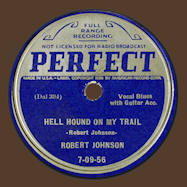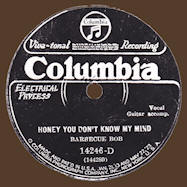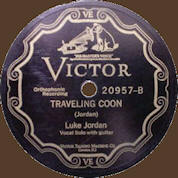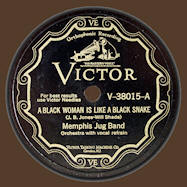
Painting © 2004 Loz
Arkle
Website
© Copyright 2000-2011 Alan White - All
Rights Reserved
Site optimised for Microsoft Internet Explorer
British Superstitions and the Blues |
||||||||||||||||||||||||||
|
Chapter II - On The Trail Of
The Hell Hound Although in Chapter III I shall be looking at beliefs and superstitions from the British Isles which have been carried over to the U.S.A. and into black society and the Blues, I have treated the legends of the "spectral hounds" separately, as it seemed so prevalent in most areas of Britain. Also of course, one of the most atmospheric Blues ever recorded, invoked the hell hound with all its Satanic trappings, and was titled "Hell Hound On My Trail", recorded in 1937. Of course, tales of devilish dogs with large, glaring eyes, etc. can all ultimately be traced back to Cerberus, the three-headed monster from the Greek underworld of Hades (see Fig. I), the 'Guardian to the Gates of Hell'.
In Scandinavian legend "Hel was the ill-favoured goddess of a gloomy place, which was the Norse underworld. Norsemen who fell in battle went to Valhalla, all others went down to Hel's underworld." (1). Possibly, an early English broadside ballad first popularised the name 'hell hound' drawing on the Scandinavian legend. The ballad called "The Dead Man's Song" tells how a man's body has apparently "died" and while his family and friends mourn and prepare for his funeral his soul goes on a visit first returning to his body, and on regaining consciousness or "coming back from the dead", relates the story to shocked relations and neighbours. On describing his visit to Hell, he included the following lines:
This, like the other ballads in this volume was printed between 1560 and 1700 and is the only song on this side of the Atlantic (to date-1991) that refers to hell hounds, that I have come across, and is also the earliest. Partridge concurs when he says that the term "hell-hound" dates from the sixteenth century and became obsolete by the twentieth; although it lived on in the world of the Blues and the U.S. working-class, black citizen. Partridge says of "hell-hound" that it was "Perhaps originally colloquial but certainly soon Standard English"(3). His definition reads "A man or a woman of a devilish character."(4). Alternative names are given as "hell-borne babe", "hell-cat", "hell-hag", or "hell-kite""(5). However, the hell hound as a mythical and hellish beast persisted well into the nineteenth century in Britain and in Devon and Cornwall in particular. Clapton quotes the Webster Dictionary: "Webster's defines "hellhound" as "dog of hell, as Cerberus, in Greek and Roman mythology; the three-headed dog guarding the gate of Hades."(6). In the famous Sherlock Holmes story "The Hound Of The Baskervilles", reference is made to "a hound of hell"(7), and to "The hell-hound of the legend"(8). In the story, the legend is dated from 1742. In a dedication at the beginning, Conan Doyle says "MY DEAR ROBINSON: It was your account of a west country legend which first suggested the idea of this little tale to my mind. For this, and for the help which you gave me in its evolution, all thanks."(9). One old Cornish tale of unknown date relates how a 'poor herdsman' who was crossing the moors one windy night, came across a hunter and the "dandy dogs": "the former with saucer-eyes, horns and tail, was clearly the Devil. He carried a long hunting-pole. There were many dogs each snorting fire and yelping horribly."(10). The frightened herdsman falls on his knees end begins to pray. "At once the hellhounds stood at bay, and the hunter cried out "Bo shrove", which in the old Cornish tongue means "The boy prays". Then they all drew back and disappeared."(11). The 'Devil's Dandy Dogs' are described as "A pack of fire-breathing black hounds found in Cornwall. They had livid fiery eyes, and followed the devil over lonely moors on stormy nights. If they captured humans they tore them apart limb by limb."(12). But the west country was not the only place to find this phenomenon. "A tradition found in almost every English county and most North European lands is that of the Wild Hunt. This was a band. of spectral huntsmen who could be heard riding past with a noise of shouting, horn-blowing, and the baying of dogs...The hounds were variously said to be the souls of unbaptised children, condemned sinners, or demon dogs. In Devon they were called Wish-hounds or Yeth-hounds, in Yorkshire Gabriel Ratchets or Gabriel hounds,"(13). Hole elaborates on the Yeth-hounds: "A child who dies unbaptised is thought to be shut out from heaven, and for this reason it cannot be buried in consecrated ground. In Devon such a child becomes one of the Yeth Hounds who hunt over the moor with the Devil."(14) These spectral dogs or hounds appeared in other scenarios besides the Wild Hunt. "Many country lanes were haunted by black or white dogs which went by different names in different localities. They were usually described as being of abnormal size, with broad feet which sometimes pointed backwards, shaggy mane and fierce. "saucer eyes""(15). A 17th. century writer is quoted referring to different kinds of devils. They will "... sometimes appear in the likeness of Hares, Crowes, black Dogs etc."(16). The black dog is synonymous with the hell hound and is well-known throughout the British Isles. Each region having a local name "Black Shuck in Norfolk, the Pooka in Ireland, the Gurt Dog in Somerset, ...'Whatever it is called, the phenomenon is everywhere the same, a fearful creature haunting certain spots and old tracks, the sight of which can make a man faint with horror."(17). One undated report from Devon describes a big black dog running off while "a stream of sulphurous vapour issued from its throat."(18), implying its hellish origins. It is normally connected with "churchyards, crossroads, watercourses and stretches of old roads. It is also commonly taken as an omen of death."(19).
Under the
heading "Ghosts", Jacqueline Simpson reports "The most common of all are
the black dogs"(20), and "In the Trelleck area in 1904 Miss Wherry heard
several vivid descriptions of such creatures from a farmer's wife whose
family seem to have seen them quite frequently; one was 'a great black
beast with flaming eyes'...and yet another, which the woman had seen
herself, was 'a big, big black dog, as large as a calf, an' his eyes
shone like lumps of fire'."(21). Leaving Monmouthshire, we find "Similar
spectral hounds were talked of round Bishop's Castle, Mountford church,
Broomfield and Baschurch in Shropshire,"(22). But as if these horrors
were not bad enough "There was also a widespread belief in an even more
ominous pack of spectral dogs, the Hell Hounds; they could be heard
howling high in the air before the death of some particularly evil man,
whose soul would be their prey. Usually their eerie howls were said to
be loud and shrill, but near
Trelleck some people said they
Meanwhile, from the Greenwood area in the Mississippi Delta, Robert Johnson, was in Dallas, Texas, for a recording session for A.R.C. record company on a summer day in June, 1937; as referred to earlier. Johnson, the archetypal Blues singer, performed his famous and almost "unworldly" blues "Hell Hound On My Trail":
Of all Blues singers, Johnson, is accredited with being the most likely as a man possessed by the Devil. Many references are made about his tormented soul living in perpetual dread of something hellish that pursued him to the end of his short life; he died in 1938 aged 27 of alleged poisoning by a jealous woman, or her husband! Johnson created a 'near-Satanic' atmosphere on "Hell Hound". His agonised vocal and bitter-sweet guitar creating a dissonance that dripped of brimstone, which pervaded even the comparatively trite words of the second verse. Hot Foot Powder is one of the charms supplied by the hoodoo man (see Ch. I.) and Johnson's reference to 'rider' is a form of address to a lover. Certainly, other references in his Blues would seem to indicate that a Hellish appointment was imminent with the Devil's 'Dandy Dogs':
His worst fears realised, he sounds almost resigned, or numbed with terror, to the inevitable:
If the Hell Hounds or the 'Devil's Dandy Dogs' were indeed seeking "souls for their prey", as British superstition has it, then Johnson's must surely have been one of them. The singer, obviously realising this, looks for the escape of his 'evil spirit' in the shape of an earth-bound, trans-continental bus!
This reflected many a black's solution in the physical world, in the South, when the oppression of whites and racial 'Jim Crow' laws of segregation or a rocky marriage/relationship became intolerable; the highways and railroads represented escape and freedom. The black dog was prevalent in the Southern states elsewhere. Johnson was from Hazlehurst County in northern Mississippi (the Delta). Around the same time he was recording "Hell Hound", in the Georgia See islands, tales from coastal blacks included this one "One night comin down duh road, I git tuh place weah road turn, an I hear sumpm behine me runnin' long close tuh ground. He pas close tuh me, an he look a me. I see urm good. He got long tick haiah lak Noofounlan (Newfoundland) . Deah ain nebuh bin dog lak um on ilun. He must be shadduh.."(28). A 'shadduh' was classed in the same category as a ghost or 'hant'. Also a story, told more than once, about requiring permission from the spirits to enter a graveyard and what happened if this requirement was not met. "Grant Johnson he go deah one time tuh cut wood widout askin' leab. He bury cuttin' wood wen all ub a sudden, he see big black dog, comin' tuh um wid one paw raise an red eye an grinnin' teet. Grant he ain lose no time in gittin' way. Dat dog wuz shadduh wut come, attuh um."(29). In Atlanta, in 1928, another singer elaborated on this tale. In his "Next Week Sometime", Alec Johnson (no relation presumably?) goes to the graveyard at midnight to dig up some gold, which a fortune-teller has told him is buried there. The 'big, black dog' has been transformed into 'a form all dressed in white' who offers to help him dig! The gist of Johnson's answer is 'maybe next week sometime, but brother, not now!!'.
It seems
quite likely, as Johnson was one of the first Blues singers to draw on
other
Blues records for ideas and lyrics. But this did not
make him an eclectic artist; far from it, if the Blues singer often
personified the Blues in his/her songs, then Robert Johnson almost
BECAME the Blues and is a genius of the genre. In any event, both J.T.
Smith and Johnson would ultimately be able to gain inspiration (and
confirmation?) from the adoption of the tales of the Black Dog/Hell
Hound, so prevalent even at the turn of the century, in British
superstition. Notes I.Paine. ibid.p.15. 2.Chappell W.p? 3, Partridqe E.p.438 4.Ibid. 5.Tbid. 6.Clapton E. 7.Symons J.p.675. 8.Ibid.p.681. 9.Ibid.p.668. 10.Briggs K.M.p.74. "A Dictionary Of etc. 11.Ibid. 12.Barber R. & A. Riches.P.46. 13.Hole.ibid.p.141. 14.Ibid.p.7. 15.Ibid.p.I48. 16.Briggs.p.52. "Pale Hecate's etc. 17.Michell J. & R.J.M. Richard.-p.122. 18.Ibid. 19.Ibid. 20.Simpson.ibid.p.89. 21.Ibid, 22.Ibid.p.90. 23.Ibid. 24.Robert Johnson. "Hell Hound etc. 25. ---""--- "Stones In etc. 26.---""--- "Me And etc. 27.Ibid. 28.Georgia Writers' Project.ibid.p.160. 29.Ibid.p.168. 30.Moore D.P.15. Illustration
Fig.I. Paine.ibid. Opp. p.64. © Copyright 1992 Max
Haymes
Back
to essay overview
Website © Copyright 2000-2011 Alan White. All Rights Reserved. |
||||||||||||||||||||||||||








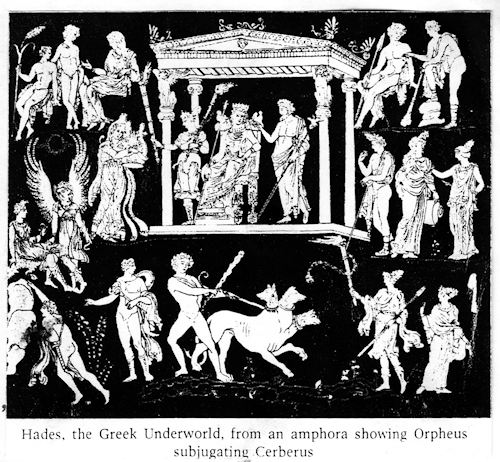
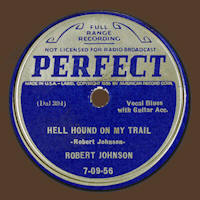
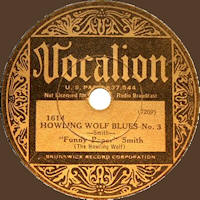 Perhaps Robert Johnson drew some inspiration from a Texas Blues singer,
J.T. 'Funny Paper' Smith: "the image of the hellhound is also to be
found on J.T. Smith's 'Howling Wolf Blues-No,3', recorded in 1931, six
years before Johnson's song.
Perhaps Robert Johnson drew some inspiration from a Texas Blues singer,
J.T. 'Funny Paper' Smith: "the image of the hellhound is also to be
found on J.T. Smith's 'Howling Wolf Blues-No,3', recorded in 1931, six
years before Johnson's song.